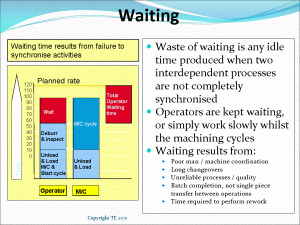The Waste of Waiting
Waiting is one of the seven wastes of lean manufacturing (or 7 mudas), it is the act of doing nothing or working slowly whilst waiting for a previous step in the process. How many times have you seen operators stood waiting for a previous operation, a delivery of products to arrive or just slowly working so as not to highlight that they have run out of materials.
The Costs of the waste of Waiting
You pay for the time spent by all of your employees, time that they do not spend adding value while they are waiting. Waiting is not something that your customer is going to want to pay for, the cost of the time spent waiting will come direct from your profit, for every penny you can save it is a penny put straight back into your profit.
Often the time spent waiting is made up later during overtime at a premium rate, good for your employees but not so good for your profit.
Causes of the Waste of Waiting.
Unbalanced processes are a cause of waiting in your flow, if one process takes longer than the next then the operators will either be stood there idle waiting or they will be performing their tasks at a speed that makes it appear that they have work to complete.
Unreliable processes also cause waiting, the next process either waiting for the previous due to breakdowns, quality issues, information, or for an overlong changeover to be completed.
The waste of Overproduction and waste of Inventory also cause the waste of waiting, this is due to the fact that this material has to be transported (another waste) from one location to the next usually as a large batch. The material handling is often a limited resource and the processes are left waiting for the forklift truck to appear or for a neighbor to finish using the pump truck and so on.
Information (or lack of it) can also cause waiting, either through unclear or missing information to conduct an operation or even through waiting to know which product is required to be run next.
Examples of wastes of Waiting
- Operators / Machines standing idle whilst they wait for a previous processes production to be sorted due to quality problems.
- Waiting for a breakdown to be resolved.
- Waiting for a previous process to complete a batch of material prior to movement.
- Waiting for the forklift truck to deliver a batch of components.
- Waiting for information from the engineering department.
- Waiting to be told which product is required next.
- Operators waiting or working slowly whilst waiting for a previous operation to complete its cycle.
How to eliminate or reduce Waiting
Balancing of your production processes using Takt time and Yamazumi boards will help ensure that the processes are better matched with regards to cycle times.
Improving machine reliability and quality using Total Productive Maintenance (TPM) and quality tools.
Reducing overproduction and inventory to minimize transport and movement between and within cells.
Implement Standard Operating Procedures to ensure that standards and methods are clear.
Use visual methods of planning combined with daily cell meetings to ensure that everyone is clear what is required for the day.
Eliminate the waste of waiting and the other seven wastes to increase Profit.
By eliminating or reducing waiting you will improve the productivity of your workers and reduce your costs, for every dollar that you reduce your costs you will add one to your profit. The same will be true for reducing and eliminating the other seven wastes of lean;
The waste of inventory; your finished goods stock, work in progress or WIP, and raw materials.
The waste of waiting; standing idle or marking time whilst waiting for materials, information, or instruction.
The waste of Motion; movements of man or machine in excess of the minimum trully required.
The waste of Overproduction; producing too great a quantity or in advance of customer requirements.
The waste of Over-processing; performing operations that the customer does not require.
The waste of Defects; incorrect service or parts either in house or delivered to the customer.
The waste of Resources; the inability to conserve our natural resources delivered to you as electricity, gas, water and materials.
The waste of people‘s creativity and talent; not using your best asset, the people in your organization.
The waste of Transport; the transportation of product between different locations.
Reduction in the causes of Muda, muri and mura by application of lean principles will help you to realize the benefits of lean manufacturing for your business and help you to not only increase business profits but to thrive as a business and out compete your competition.

